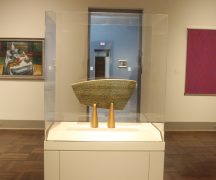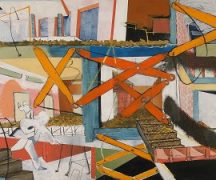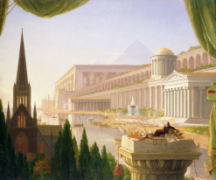From TOLEDO MUSEUM OF ART
In Black Orpheus:Jacob Lawrence and the Mbari Club, on view June 3-Sept. 3, the Toledo Museum of Art (TMA) will present works by Jacob Lawrence seen together for the first time in more than five decades and introduce new scholarship about his extended stay in Nigeria.
The exhibition of 110 objects pairs Lawrence’s works produced during his time in Nigeria with paintings, sculptures, reliefs and works on paper by Mbari Artists and Writers Club members, including Twins Seven-Seven, Muraina Oyelami, Asiru Olatunde and Jacob Afolabi. Out-of-print copies of Black Orpheus (1957-67), a Nigeria-based literary journal, will acquaint visitors with works by African and African Diasporic writers and visual artists.
“Black Orpheus emphasizes Jacob Lawrence’s global impact through his work and the work of other international artists who used visual arts to reframe their national and cultural identities as countries around the world established their independence. The Toledo Museum of Art is eager to share this vibrant and important exhibition with our Toledo audience and with the broader region,” said Adam M. Levine, the Toledo Museum of Art’s Edward Drummond and Florence Scott Libbey director.
Lawrence first visited the Nigerian cities of Lagos, Osogbo and Ibadan in 1962 for 10 days to exhibit samples from his Migration(1941) and War (1946-47) series. After showing his work in Lagos at the West African headquarters for the American Society of African Culture (AMSAC) — an organization that promoted African culture to Americans — German cultural critic Ulli Beier requested to show the work in Ibadan at the Mbari Artists and Writers Club, of which Beier was a co-founder.
In 1964, Lawrence returned with his wife Gwendolyn Knight for an eight-month stay, part of which was hosted by Beier. Lawrence’s residency in Nigeria placed him in conversation with Mbari Club members, including prominent figures within modern African art and literature such as Bruce Onobrakpeya, Vincent Kofi, Wole Soyinka and Chinua Achebe. During his stay, he produced his Nigeria series, tempera and gouache paintings and nine crayon and ink drawings of Lagos and Ibadan marketplaces that he presented at the Terry Dintenfass Gallery in New York in 1965.

Black Orpheus: Jacob Lawrence and the Mbari Club chronicles Lawrence’s journey and showcases the artists with whom he shared a mutual admiration in five sections: Nigeria, Artists of Osogbo, Zaria Art Society, Across the African Continent and Beyond the African Continent. Each section builds upon Lawrence’s time in Nigeria, the thriving art scene he connected with while there and the ongoing legacy of African American artists venturing to the African continent for knowledge and inspiration.
Some of the works on view in the upcoming section of the exhibition depict bustling streets and marketplaces that characterized modern life in Nigeria and were often subjects of Lawrence’s letters to friends back in the United States. Works such as Market Scene (1966) brim with vibrant colors that introduce viewers to fabric patterns that were sold in Lagos markets.
The influence of older Western and non-Western artists is apparent in the Artists of Osogbo section. Their printmaking, batik textiles and painting techniques appear in many works by younger artists such as Twins Seven-Seven, who attended Mbari Mbayo workshops led by British artist Georgina Beier and produced works such as Sea Ghost III that focused on Yoruba mythology. Western art techniques, local aesthetics and cultural traditions come together in the Zaria Art Society portion of the exhibition. These artists, many of whom were considered rebels, desired to pair Indigenous practices with Western techniques to produce Nigeria’s new national identity.
Visitors will encounter Alexander “Skunder” Boghossian and other artists who worked outside of Nigeria in the Across the African Continent and Beyond the African Continent sections. Many of these artists, though trained in European styles, incorporated local iconography and stories to present works that were unique to their culture. Boghossian merged Surrealism with Coptic Christian iconography and African history in his semi-abstract works. Other artists featured in these sections were from Brazil, India, Japan and beyond.
Black Orpheus and the Mbari Club gallery space led to numerous African artists having their first published art reviews and art exhibitions in Nigeria. Among this group of now iconic modernist artists from around the world are Lawrence, William H. Johnson, Onobrakpeya, Kofi, Ibrahim El-Salahi, Francis Newton Souza, Susanne Wenger and Naoko Matsubara.
Some, including the Nigerian artists Onobrakpeya, Uche Okeke and Demas Nwoko, were highly invested in developing a visually dynamic but politically charged approach for a changing Nigerian audience. The work was associated with the artists’ self-identified cultural and national alliances, reflecting Nigeria’s and Africa’s post-colonial era. Others, such as Brazilian artist Genaro de Carvalho and Japanese artist Naoko Matsubara, were producing works that echoed the sociopolitical issues they were facing in their respective countries.
“Black Orpheus:JacobLawrenceand the Mbari Club showcases the ways in which the arts and culture journal Black Orpheus (1957–1967) promoted African art and literature internationally,” said Kimberli Gant, Ph.D., the exhibition’s co-curator. “It also allows us to explore the little-known time in Lawrence’s life when he traveled to Nigeria and it highlights a growing arts movement there driven by the Mbari Artists and Writers Club, whose members encouraged innovative approaches to art.”
Black Orpheus: Jacob Lawrence and the Mbari Club is co-organized by the Chrysler Museum of Art and the New Orleans Museum of Art. It is curated by Kimberli Gant, Ph.D., the Brooklyn Museum’s curator of modern and contemporary art and the Chrysler Museum of Art’s former McKinnon curator of modern and contemporary art, and Ndubuisi Ezeluomba, Ph.D., the Virginia Museum of Fine Art’s curator of African art and the New Orleans Museum of Art’s former Françoise Billion Richardson curator of African art.
A full-color catalogue published by Yale University Press accompanies the exhibition and includes essays by the exhibition curators and preeminent scholars including Leslie King-Hammond and Peter Probst as well as a new generation of scholars bringing forward new scholarship including Suheyla Takesh, Katrina Greven and Iheanyi Onwuegbucha.
This exhibition was made possible in part by major funding from The Andy Warhol Foundation for the Visual Arts, the Getty Foundation Paper Project, The Gladys Krieble Delmas Foundation, the National Endowment for the Arts and the Wyeth Foundation for American Art.
The exhibition’s presentation at the Toledo Museum of Art is supported locally by season sponsor ProMedica and presenting sponsors Susan and Tom Palmer, with additional support from Taylor Automotive and the TMA Ambassadors. The show is also made possible in part by the Ohio Arts Council (OAC). The OAC is a state agency that funds and supports quality arts experiences to strengthen Ohio communities culturally, educationally and economically.





